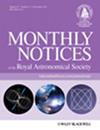估计S-PLUS星系的恒星人口和发射线性质
IF 4.7
3区 物理与天体物理
Q1 ASTRONOMY & ASTROPHYSICS
引用次数: 0
摘要
我们提出了一种新方法的测试,同时估计恒星人口和星系的发射线(EL)性质的S-PLUS光度。该技术使用的是a - 1星码,并根据经验先验进行了更新,这大大提高了仅使用调查的12个波段估计el的能力。这些测试将SDSS星系(噪声干扰)合成光度法的输出与之前的全光谱拟合和详细的EL分析得出的特性进行了比较。对于真实的信噪比,恒星的质量、平均年龄、金属丰度和±0.2等特性恢复到优于0.2的指数。更重要的是,通过光度测量可以很好地恢复光强。对于[O ii], [O iii], Hβ, Hα, [N ii]和[S ii]的等效宽度,我们获得了0.05-0.2指数的输入-输出色散,并且对于大于~ 5 Å的线甚至更好。这些优秀的结果是通过将两个经验事实结合到一个限制可用于拟合的EL空间的先验中获得的:(1)因为,对于这里探索的红移,Hα和[N ii]落在单个窄带(J0660)中,它们的组合等效宽度总是很好地恢复,即使[N ii]/Hα不是。(2)由SDSS可知$W_{\ mathm {H}\alpha +[\rm{N}\, \small {II}]}$与[N II]/Hα相关,可用于判别经典BPT诊断图中星系是属于左翼还是右翼。给出了在集成光和空间分辨数据上的应用实例,并与基于muse的积分场光谱的独立结果进行了比较。本文章由计算机程序翻译,如有差异,请以英文原文为准。
Estimating stellar population and emission line properties in S-PLUS galaxies
We present tests of a new method to simultaneously estimate stellar population and emission line (EL) properties of galaxies out of S-PLUS photometry. The technique uses the a l starcode, updated with an empirical prior which greatly improves its ability to estimate ELs using only the survey’s 12 bands. The tests compare the output of (noise-perturbed) synthetic photometry of SDSS galaxies to properties derived from previous full spectral fitting and detailed EL analysis. For realistic signal-to-noise ratios, stellar population properties are recovered to better than 0.2 dex in masses, mean ages, metallicities and ±0.2 mag for the extinction. More importantly, ELs are recovered remarkably well for a photometric survey. We obtain input − output dispersions of 0.05–0.2 dex for the equivalent widths of [O ii], [O iii], Hβ, Hα, [N ii], and [S ii], and even better for lines stronger than ∼5 Å. These excellent results are achieved by combining two empirical facts into a prior which restricts the EL space available for the fits: (1) Because, for the redshifts explored here, Hα and [N ii] fall in a single narrow band (J0660), their combined equivalent width is always well recovered, even when [N ii]/Hα is not. (2) We know from SDSS that $W_{\mathrm{H}\alpha +[\rm{N}\, \small {II}] }$ correlates with [N ii]/Hα, which can be used to tell if a galaxy belongs to the left or right wings in the classical BPT diagnostic diagram. Example applications to integrated light and spatially resolved data are also presented, including a comparison with independent results obtained with MUSE-based integral field spectroscopy.
求助全文
通过发布文献求助,成功后即可免费获取论文全文。
去求助
来源期刊

Monthly Notices of the Royal Astronomical Society
ASTRONOMY & ASTROPHYSICS-
CiteScore
9.10
自引率
37.50%
发文量
3198
审稿时长
3 months
期刊介绍:
Monthly Notices of the Royal Astronomical Society is one of the world''s leading primary research journals in astronomy and astrophysics, as well as one of the longest established. It publishes the results of original research in positional and dynamical astronomy, astrophysics, radio astronomy, cosmology, space research and the design of astronomical instruments.
 求助内容:
求助内容: 应助结果提醒方式:
应助结果提醒方式:


